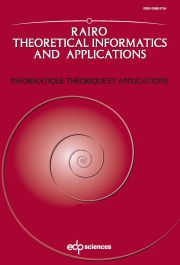Article contents
Increasing integer sequences andGoldbach's conjecture
Published online by Cambridge University Press: 20 July 2006
Abstract
Increasing integer sequences include many instances of interesting sequences and combinatorial structures, ranging from tournaments to addition chains, from permutations to sequences having the Goldbach property that any integer greater than 1 can be obtained as the sum of two elements in the sequence. The paper introduces and compares several of these classes of sequences, discussing recurrence relations, enumerative problems and questions concerning shortest sequences.
- Type
- Research Article
- Information
- RAIRO - Theoretical Informatics and Applications , Volume 40 , Issue 2: Alberto Bertoni: Climbing summits , April 2006 , pp. 107 - 121
- Copyright
- © EDP Sciences, 2006
References
Capell, P. and Narayana, T.V., Knock-out Tournaments, On.
Canad. Math. Bull.
13 (1970) 105–109.
CrossRef
L. Carlitz, D.P. Roselle and R.A. Scoville, Some Remarks on Ballot-Type Sequences of Positive Integers. J. Combinatorial Theory, Ser. A 11 (1971) 258–271.
L. Comtet, Advanced Combinatorics. Reidel, Dordrecht (1974).
M. Cook and M. Kleber, Tournament sequences and Meeussen sequences. Electron. J. Combin.
7 (2000), Research Paper 44, p. 16 (electronic).
J-M. Deshouillers, H.J.J. te Riele and Y. Saouter, New experimental results concerning the Goldbach conjecture, in Proc. 3rd Int. Symp. on Algorithmic Number Theory.
Lect. Notes Comput. Sci.
1423 (1998) 204–215.
CrossRef
Dusart, P., The kth prime is greater than k(lnk + lnlnk - 1) for k ≥ 2.
Math. Comp.
68 (1999) 411–415.
CrossRef
H. Edelsbrunner, Algorithms in Combinatorial Geometry. Springer, Berlin (1987).
P.C. Fishburn and F.S. Roberts, Uniqueness in finite measurement, in Applications of Combinatorics and Graph Theory to the Biological and Social Sciences, edited by F.S. Roberts. Springer, New York (1989) 103–137.
R.K. Guy, Unsolved Problems in Number Theory. Springer, New York, 2nd ed. (1994).
D.E. Knuth, The Art of Computer Programming, Vols. 2 and 3. Addison-Wesley, Reading (1997 and 1998).
Lagarias, J.C., The 3x + 1 problem and its generalizations.
American Math. Monthly
92 (1985) 3–23.
CrossRef
W.J. LeVeque, Fundamentals of Number Theory. Addison-Wesley, Reading (1977).
Melfi, G., Two Conjectures, On about Practical Numbers.
J. Number Theory
56 (1996) 205–210.
CrossRef
M.B. Nathanson, Additive Number Theory. Springer, New York (1996).
E. Neuwirth, Computing Tournament Sequence Numbers efficiently with Matrix Techniques. Sém. Lothar. Combin.
47 (2002), Article B47h, p. 12 (electronic).
Odlyzko, A.M., Iterated Absolute Values of Differences of Consecutive Primes.
Math. Comp.
61 (1993) 373–380.
CrossRef
Richstein, J., Verifying the Goldbach Conjecture up to 4 x 1014.
Math. Comp.
70 (2001) 1745–1749.
CrossRef
N.J.A. Sloane, The On-Line Encyclopedia of Integer Sequences. World-Wide Web URL http://www.research.att.com/~njas/sequences/
N.J.A. Sloane and S. Plouffe, The Encyclopedia of Integer Sequences. Academic Press, New York (1995).
- 1
- Cited by


